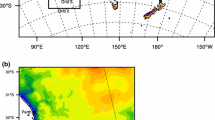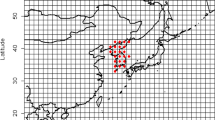Abstract
The Climate System Model (CSM) and the Parallel Climate Model (PCM), two coupled global climate models without flux adjustments recently developed at NCAR, were used to simulate the 20th century climate using historical greenhouse gas and sulfate aerosol forcing. These simulations were extended through the 21st century under two newly developed scenarios, a business-as-usual case (BAU, CO2 ≈ 710 ppmv in 2100) and a CO2 stabilization case (STA550, CO2 ≈ 540 ppmv in 2100). The simulated changes in temperature, precipitation, and soil moisture over the Asia-Pacific region (10°–60°N, 55°–155°E) are analyzed, with a focus on the East Asian summer monsoon rainfall and climate changes over the upper reaches of the Yangtze River.
Under the BAU scenario, both the models produce surface warming of about 3–5°C in winter and 2–3°C in summer over most Asia. Under the STA550 scenario, the warming is reduced by 0.5–I.0°C in winter and by 0.5°C in summer. The warming is fairly uniform at the low latitudes and does not induce significant changes in the zonal mean Hadley circulation over the Asia-Pacific domain. While the regional precipitation changes from single CSM integrations are noisy, the PCM ensemble mean precipitation shows 10%–30% increases north of ~ 30°N and ~ 10% decreases south of ~ 30°N over the Asia-Pacific region in winter and 10%–20% increases in summer precipitation over most of the region. Soil moisture changes are small over most Asia. The CSM single simulation suggests a 30% increase in river runoff into the Three Gorges Dam, but the PCM ensemble simulations show small changes in the runoff.
Similar content being viewed by others
References
Boer, G. J., G. Flato, and D. Ramsden, 2000: A transient climate change simulation with greenhouse gas and aerosol forcing: projected climate for the 21st century. Climate Dyn., in press.
Bonan, G., 1998: The land surface climatology of the NCAR Land Surface Model (LSM 1.0) coupled to the NCAR Community Climate Model (CCM3). J. Climate, 11, 1307–1326.
Boville, B. A., and P.R. Gent, 1998: The NCAR Climate System Model, version one. J. Climate, 11, 1115–1130.
Boville, B. A., and J. W. Hurrell, 1998: A comparison of the atmospheric circulations simulated by the CCM3 and CSMI. J. Climate, 11, 1327–1341.
Boville, B.A., J.T. Kiehl, P.J. Rasch, and F.O. Bryan, 2001: Improvements to the NCAR CSM-1 for transient climate simulations. J. Climate. 14, 164–179.
Bryan, F.O., B.G. Kauffman, W.G. Large, and P.R. Gent, 1996: The NCAR CSM flux coupler. NCAR Tech. Note 424, 50pp., NCAR, Boulder, CO 80307.
Cubasch, U., K. Hasselmann, H. Hoeck, E. Maier-Reimer, U. Mikolajewicz, B. D. Santer, and R. Sausen, 1992: Time-dependent greenhouse warming computations with a coupled ocean-atmosphere model. Climate Dyn., 8, 55–69.
Dai, A., T.M.L. Wigley, B.A. Beville, J.T. Kiehl, and L.E. Buja, 2001a: Climates of the 20th and 21st centuries simulated by the NCAR Climate System Model. J. Climate, 14, 485–519.
Dai, A., G.A. Meehl, W.M. Washington, T.M.L. Wigley, and J.M. Arblaster, 2001b: Ensemble simulation of 21st century climate changes: business as usual vs. CO2 stabilization. Bull. Amer. Meteor. Soc., (in press).
Dai, A., T.M.L. Wigley, G.A. Meehl, and W. M. Washington, 2001c: Effects of stabilizing atmospheric CO2 on global climate in the next two centuries. Geophys. Res. Lett., (in press).
Ding, Y.-H., 1994: Monsoons over China. Kluwer Academic Publ., Dordrecht, 419pp.
Edmonds, J., M. Wise, H. Pitcher, R. Richels, T.M.L. Wigley, and C. MacCracken, 1997: An integrated assessment of climate change and the accelerated introduction of advanced energy technologies: An application of MiniCAM 1.0. Mitigation and Adaptation Strategies for Global Change, 1, 311–339.
Gent, P.R., F.O. Bryan, G. Danabasoglu, S.C. Doney, W.R. Holland, W.G. Large, and J.C. McWilliams, 1998: The NCAR Climate System Model global ocean component. J. Climate, 11, 1287–1306.
Kalnay E., and 19 co-authors, 1996: The NMC/ NCAR 40-year reanalysis project. Bull. Amer. Meteor. Soc., 77, 437–471.
Kattenberg, A., F. Giorgi, H. Grassl, G.A. Meehl, J.F.B. Mitchell, R.J. Stouffer, T. Tokioka, A.J. Weaver, and T.M.L. Wigley, 1996: Climate models - projections of future climate. In Climate Change 1995: The IPCC Second Assessment (ed. J.T. Houghton, et al.), Cambridge University Press, Cambridge, 285–358.
Kiehl, J.T., J.J. Hack, G.B. Bonan, B.A. Boville, D.L. Williamson, and P.J. Rasch, 1998: The National Center for Atmospheric Research Community Climate Model: CCM3. J. Climate, 11, 1131–1150.
Manabe, S., R. J. Stouffer, M. D. Spelman and K. Bryan, 1991: Transient response of a coupled ocean-atmosphere model to gradual changes of atmospheric CO2. Part I: Annual mean response. J. Climate, 4, 785–818.
Meehl, G.A., and J.M. Arblaster, 1998: The Asian-Australian monsoon and El Nino-Southern Oscillation in the NCAR Climate System Model. J. Climate, 11, 1356–1385.
Meehl, G. A., W. D. Collins, B. Beville, J. T. Kiehl, T.M.L. Wigley, and J. M. Arblaster, 2000a: Response of the NCAR Climate System Model to increased CO2 and the role of physical processes. J. Climate, 13, 1879–1898.
Meehl, G.A., G.J. Boer, C. Covey, M. Latif, and R.J. Stouffer, 2000b: The Coupled Model Intercomparison Project (CMIP). Bull. Amer. Meteor. Soc., 81, 313–318.
Meehl, G.A., P.R. Gent, J.M. Arblaster, B. Otto-Bliesner, E.C. Brady, and A.P. Craig, 2001: Factors that affect amplitude of El Niilo in global coupled climate models. Climate Dyn., 17, 515–526.
Mitchell, J. F. B, S. Manabe, V. Meleshko and T. Tokioka, 1990: Equilibrium climate change and its implications for the future. In: Climate Change: the IPCC Scientific Assessment (ed. J.T. Houghton, G.J. Jenkins and J.J. Ephraums), Cambridge University Press, Cambridge, 131–172.
Mitchell, J. F. B., T. C. Johns, J. M. Gregory, and S. F. B. Tett, 1995: Climate response to increasing levels of greenhouse gases and sulfate aerosols. Nature, 376, 501–504.
Roeckner, E., L. Bengtsson, J. Feichter, J. Lelieveld, and H. Rodhe, 1999: Transient climate change simulations with a coupled atmosphere-ocean GCM including the tropospheric sulfur cycle. J. Climate, 12, 3004–3032.
Russell, G. L. and D. Rind, 1999: Response to CO2 transient increase in the GISS coupled model: regional coolings in a warming climate. J. Climate, 12, 531–539.
Schimel, D. and 26 co-authors, 1996: Radiative forcing of climate change. In Climate Change 1995: The IPCC Second Assessment (ed. J.T. Houghton, et al.), Cambridge University Press, Cambridge, U.K., 65–132.
Washington, W.M., J.W. Weatherly, G.A. Meehl, A.J. Semtner Jr., T.W. Bettge, A.P. Craig, W.G. Strand Jr., J.M. Arblaster, V.B. Wayland, R. James and Y. Zhang, 2000: Parallel Climate Model (PCM) control and transient simulations. Clim. Dyn., 16, 755–774.
Watson, R. T., H. Rodhe, H. Oeschger and U. Siegenthaler, 1990: Greenhouse gases and aerosols. In: Climate Change, The IPCC Scientific Assessment (ed. J.T. Houghton, G.J. Jenkins and J. J. Ephraums), Cambridge University Press, Cambridge, U.K., 1–40.
Weatherly, J. W., B. P. Briegleb, W.G. Large, and J. A. Maslanik, 1998: Sea ice and polar climate in the NCAR CSM. J. Climate, 11, 1472–1486.
Xie, P., and P. A. Arkin, 1997: Global precipitation: a 17-year monthly analysis based on gauge observations, satellite estimates and numerical model outputs. Bull. Amer. Meteor. Soc., 78, 2539–2558.
Author information
Authors and Affiliations
Corresponding author
Additional information
The National Center for Atmospheric Research is sponsored by the U. S. National Science Foundation.
Rights and permissions
About this article
Cite this article
Dai, A., Meehl, G., Washington, W. et al. Climate Changes in the 21st Century over the Asia-Pacific Region Simulated by the NCAR CSM and PCM. Adv. Atmos. Sci. 18, 639–658 (2001). https://doi.org/10.1007/BF03403491
Received:
Published:
Issue Date:
DOI: https://doi.org/10.1007/BF03403491




